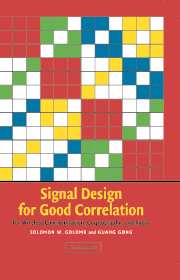Book contents
- Frontmatter
- Contents
- Preface
- Acknowledgments
- Historical Introduction
- 1 General Properties of Correlation
- 2 Applications of Correlation to the Communication of Information
- 3 Finite Fields
- 4 Feedback Shift Register Sequences
- 5 Randomness Measurements and m-Sequences
- 6 Transforms of Sequences and Functions
- 7 Cyclic Difference Sets and Binary Sequences with Two-Level Autocorrelation
- 8 Cyclic Hadamard Sequences, Part 1
- 9 Cyclic Hadamard Sequences, Part 2
- 10 Signal Sets with Low Crosscorrelation
- 11 Correlation of Boolean Functions
- 12 Applications to Radar, Sonar, Synchronization, and CDMA
- Bibliography
- Index
12 - Applications to Radar, Sonar, Synchronization, and CDMA
Published online by Cambridge University Press: 15 August 2009
- Frontmatter
- Contents
- Preface
- Acknowledgments
- Historical Introduction
- 1 General Properties of Correlation
- 2 Applications of Correlation to the Communication of Information
- 3 Finite Fields
- 4 Feedback Shift Register Sequences
- 5 Randomness Measurements and m-Sequences
- 6 Transforms of Sequences and Functions
- 7 Cyclic Difference Sets and Binary Sequences with Two-Level Autocorrelation
- 8 Cyclic Hadamard Sequences, Part 1
- 9 Cyclic Hadamard Sequences, Part 2
- 10 Signal Sets with Low Crosscorrelation
- 11 Correlation of Boolean Functions
- 12 Applications to Radar, Sonar, Synchronization, and CDMA
- Bibliography
- Index
Summary
Overview
In the first three of the applications mentioned in the title of this chapter, one of the objectives (often the major objective) is to determine a point in time with great accuracy. In radar and sonar, we want to determine the round-trip time from transmitter to target to receiver very accurately, because the one-way time (half of the round-trip time) is a measure of the distance to the target (called the range of the target).
The simplest approach would be to send out a pure impulse of energy and measure the time until it returns. The ideal impulse would be virtually instantaneous in duration, but with such high amplitude that the total energy contained in the pulse would be significant, much like a Dirac delta function. However, the Dirac delta function not only fails to exist as a mathematical function, but it is also unrealizable as a physical signal. Close approximations to it – very brief signals with very large amplitudes – may be valid mathematically, but are impractical to generate physically. Any actual transmitter will have an upper limit on peak power output, and hence a short pulse will have a very restricted amount of total energy: at most, the peak power times the pulse duration. More total energy can be transmitted if we extend the duration; but if we transmit at uniform power over an extended duration, we do not get a sharp determination of the round-trip time. This dilemma is illustrated in Figure 12.1.
- Type
- Chapter
- Information
- Signal Design for Good CorrelationFor Wireless Communication, Cryptography, and Radar, pp. 403 - 424Publisher: Cambridge University PressPrint publication year: 2005



